Have you ever wondered about how safe your place or position is regarding electromagnetic and magnetic fields? Then here is your chance to find out. Everyone is exposed to a complex mix of weak electric and magnetic fields, both at home and at work, from the generation and transmission of electricity, domestic appliances and industrial equipment, to telecommunications and broadcasting.
There are different views how those field can affect you. There are established biological effects from acute exposure at high levels (well above 100 µT) that are explained by recognized biophysical mechanisms. But foe low level field there is no one universal truth. Some members of the public have attributed a diffuse collection of symptoms to low levels of exposure to electromagnetic fields at home, but there is no solid evidence on those. To date, scientific evidence does not support a link between various symptoms and exposure to electromagnetic fields. IARC published a monograph classifying ELF magnetic fields as “possibly carcinogenic to humans”. According to IARC there has been found increase in childhood leukaemia associated with average exposure to residential power-frequency magnetic field above 0.3 to 0.4 µT. But there are no accepted biophysical mechanisms that would suggest that low-level exposures are involved in cancer development.
The Shady Science of Ghost Hunting often makes use of different kind of detectors, including EMF meters. EMF meter is among the most common devices used by ghost hunters today. The association between EMF meters and ghosts is frequently made, but there is no firm evidence connecting the two. I don’t believe in ghosts, bit I thought this should be mentioned here.
Electromagnetic fields can also affect electronics. Electromagnetic interference (EMI) is a disturbance generated by an external source that affects an electrical circuit by electromagnetic induction, electrostatic coupling, or conduction. Both man-made and natural sources generate changing electrical currents and voltages that can cause EMI. In case electrical circuit receives unwanted EMI, a meter that can give idea of EMI around the circuit can be helpful in fault finding.
An EMF meter is a scientific instrument for measuring electromagnetic fields (abbreviated as EMF).EMF meters measure fluctuations in electromagnet fields. Measurements of the EMF are obtained using an E-field (electrical field) sensor or H-field sensor (magnetic field). I have earlier tested Velleman VTEMF meter for measuring alternating magnetic fields (calibrated to measure 50 and 60 Hz alternating fields ). I have also tested DT-1180 Electrical field and RF meter for measuring electrical fields. This time I am testing GM3120 Electric Magnetic Radiation Detector Tester Phone PC Home Equitment Radiation Monitoring with Lcd Display product that promises to measure both magnetic field and electrical field at the same time. It’s interesting to see how much electromagnetic radiation around us at home!
- can test the electric field and the magnetic field radiation at the same time
- Unit: V/m (Electric Field); μT(Magnetic Field)
- Measurement range: Electric: 1-1999V/m; Magnetic: 0.01-19.99μT
- sound-light alarm, when the test result exceeds the safe value, the instrument will alarm automatically.
- Alarm Threshold: Electric: 40V/m; Magnetic: 0.4μT
- data locking key
- LCD display (3-1/2 LCD Display)
- processing by control micro-chip
- Test Bandwidth: 5Hz-3500MHz
- Sampling Time: Approx. 0.4 Seconds
- Power Supply: 1 x 6F22 9V Battery
- Size: 12.5 x 6 x 3cm / 4.92 x 2.36 x 1.18in (L x W x H)
- Weight: 109g / 3.84oz
Data on back
I am still testing this EMF n detector but it already comes out with some interesting results. Item performance are quite satisfactory, considering its cheapy price. It is easy to use. It detect well mains frequency fields. The alarm levels are so low that the meter alarms very often in very many locations at a normal house. That’s a bit annoying and make you want to turn off the alarm beep (that can be done with button). With alarm turned of it can be used as quite nice EMF field surveying instrument.
Device performance are quite satisfactory, considering its cheapy price. It detects the 50 Hz or 60 Hz of main power and electrostatic charges well. At those measurements the performance was pretty much in line the separate instruments I had, meaning that they gave somewhat similar looking results (I did not have any tightly controlled lab to test the actual accuracy). This device can detect mains power cables in walls. In addition the device seems to detect also radio frequency signals (Wifi at 2.4GHz, PMR at 446 MHz, cellular phone). The meter seems to pick up electrical fields towards top end best. For magnetic fields it seems to pick strongest the fields from the side of the meter. In real world field testing you should try neter in different directions ti get reading from strongest electrical and magnetic fields.
The plastic case of this device is very cheap looking and has cheap feeling. Otherwise the construction seems to be OK. The measurement works OK, but sometimes the response to the changing fields seems to be somewhat slow.
Here are some measurement results with PRM446 (446 MHz radio with maximum power of 500 mW ):
Magnetic field next to big utility transformer that powers several buildings:
A look at the electrical and magnetic fields near 110 kV power line:
Some useful conversions between units are:
1 uT = 0.7958 A/m
1 A/m = 1.257 uT
1 T = 10,000 gauss
Here is a look inside the EMF meter:
The piece of bare circuit board on the front of the device acts like capacitive sensor for electrical field. The red component that looks like big resistor is a coil used for picking up magnetic field.
Her you can see the circuit more closely. It looks like the signal from electrical field sensor is amplified with FET and the signal from coil goes pretty directly to the rest of the circuitry.
GM3120 Electric Magnetic Radiation Detector Tester seems to work and do measurements. With my short testing it is hard to say how accurate this device really is on different situations and at different frequencies. The manufacturer has web page for GM3120.
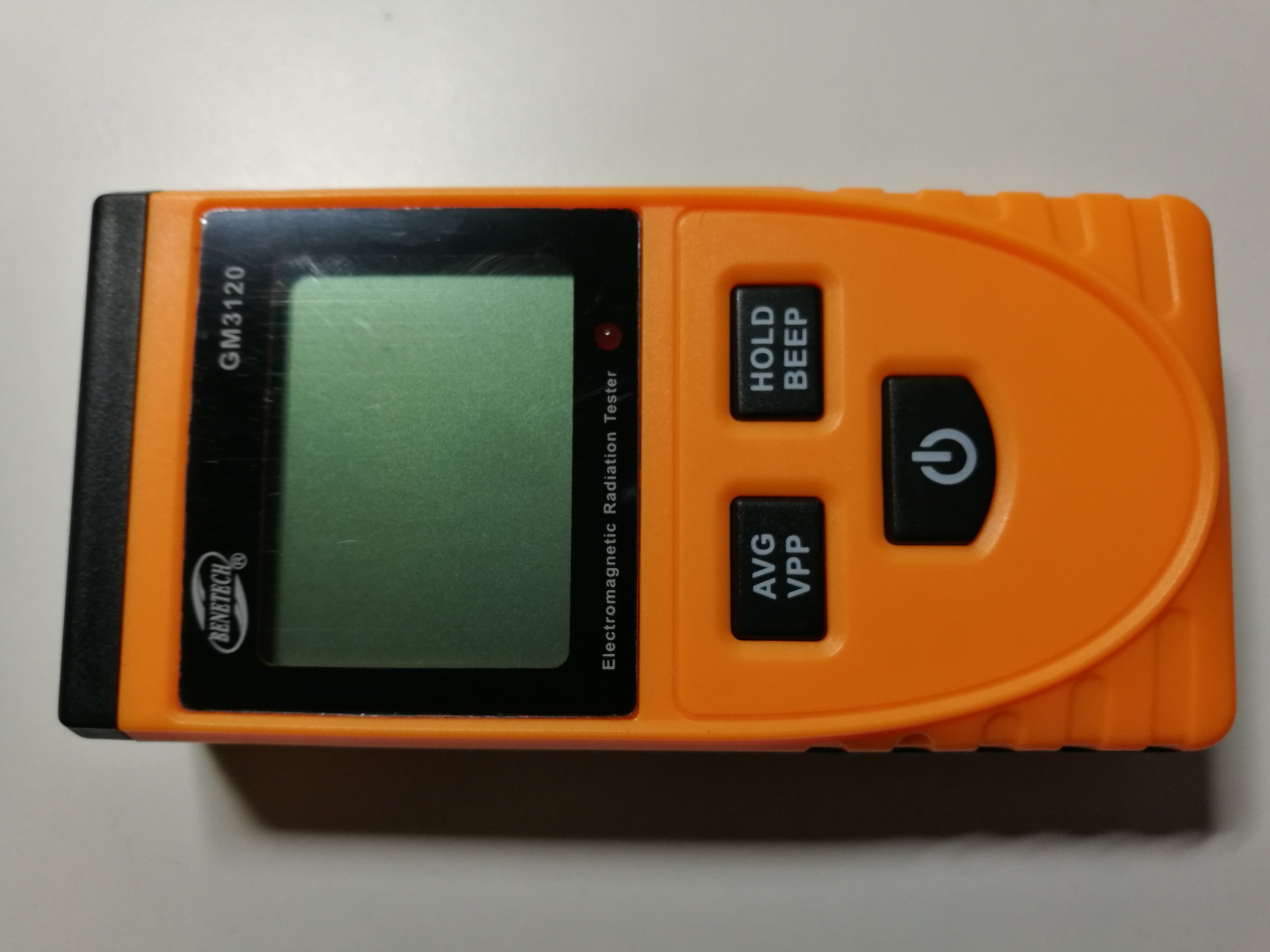
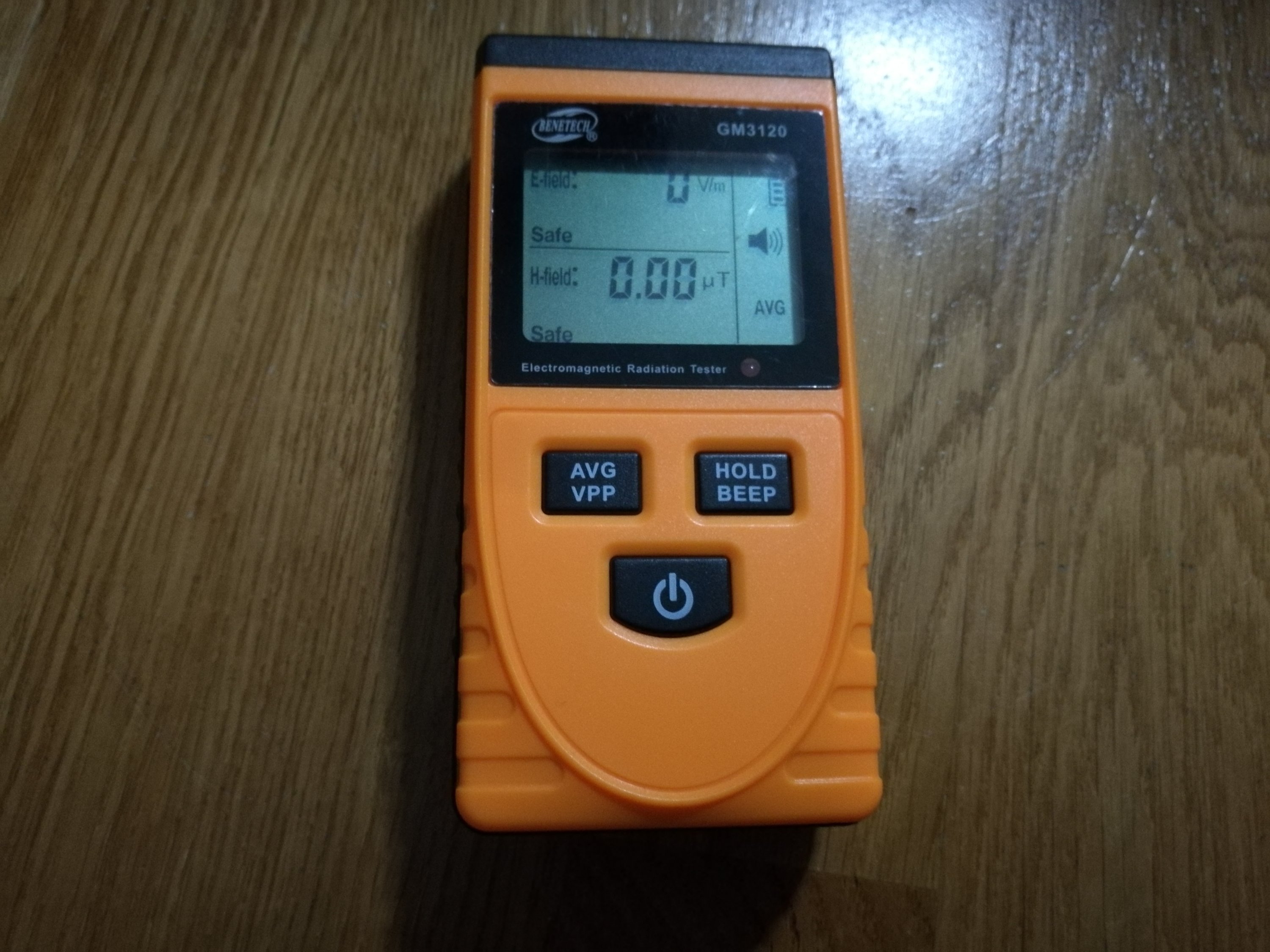
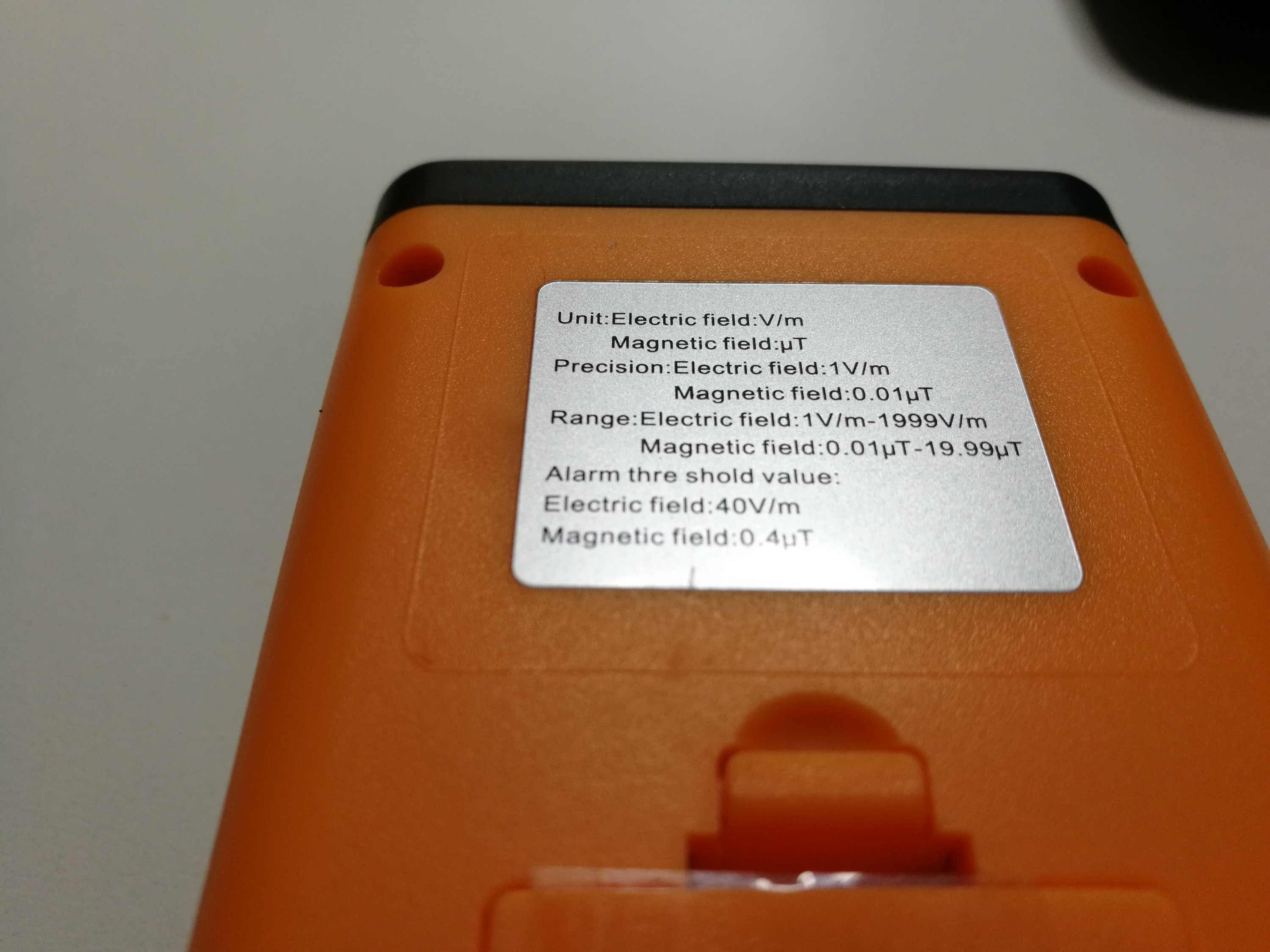
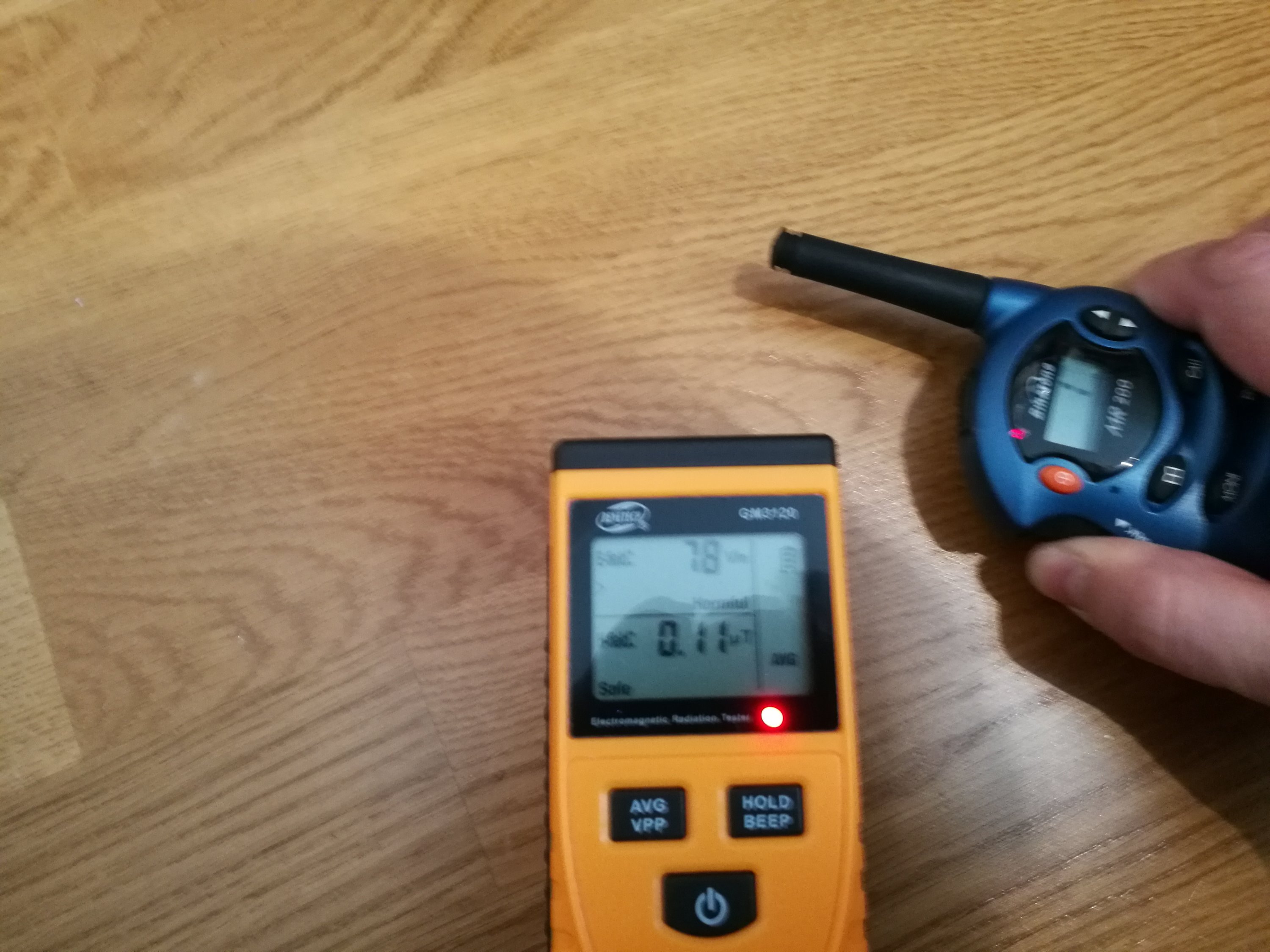
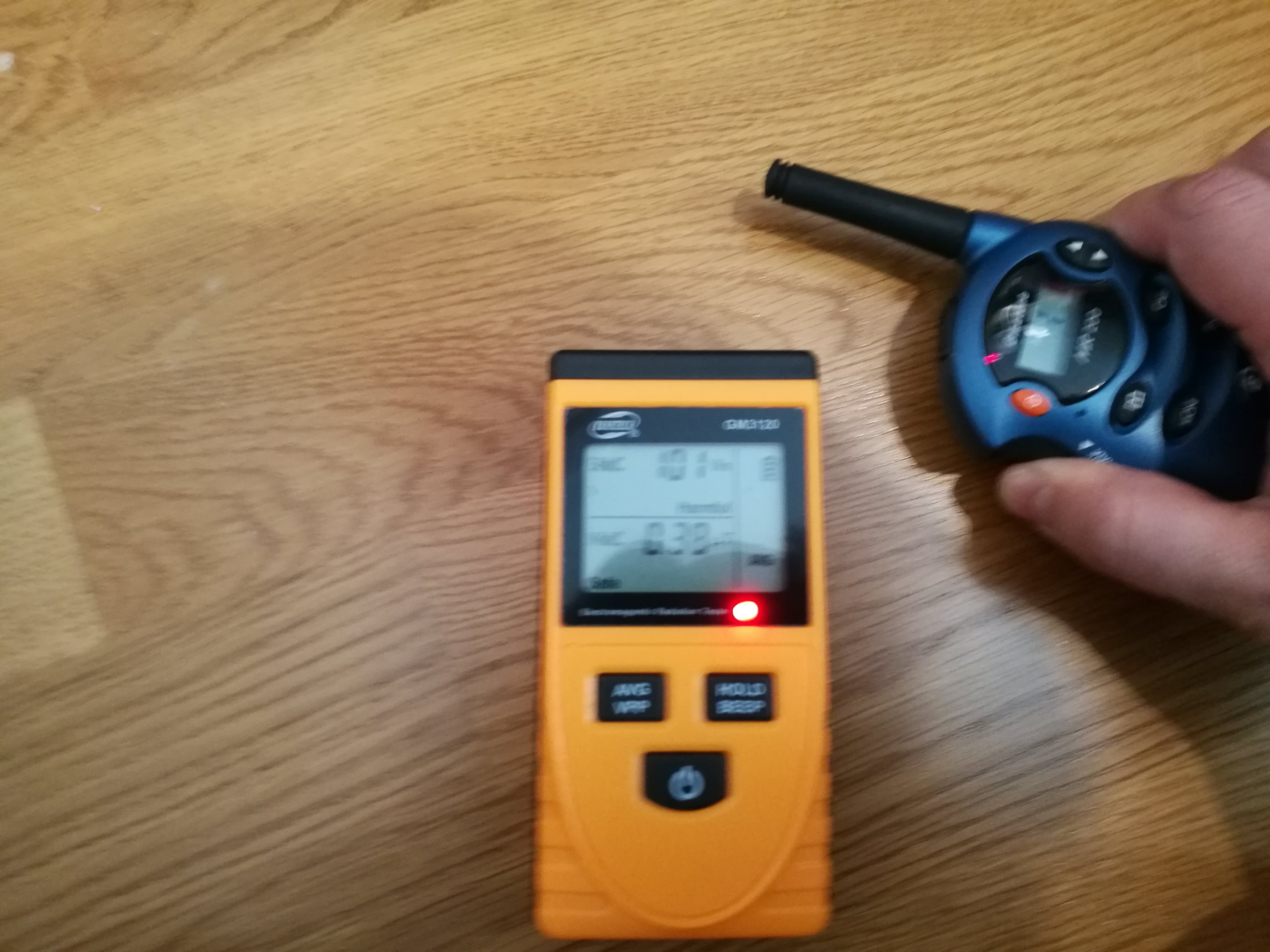
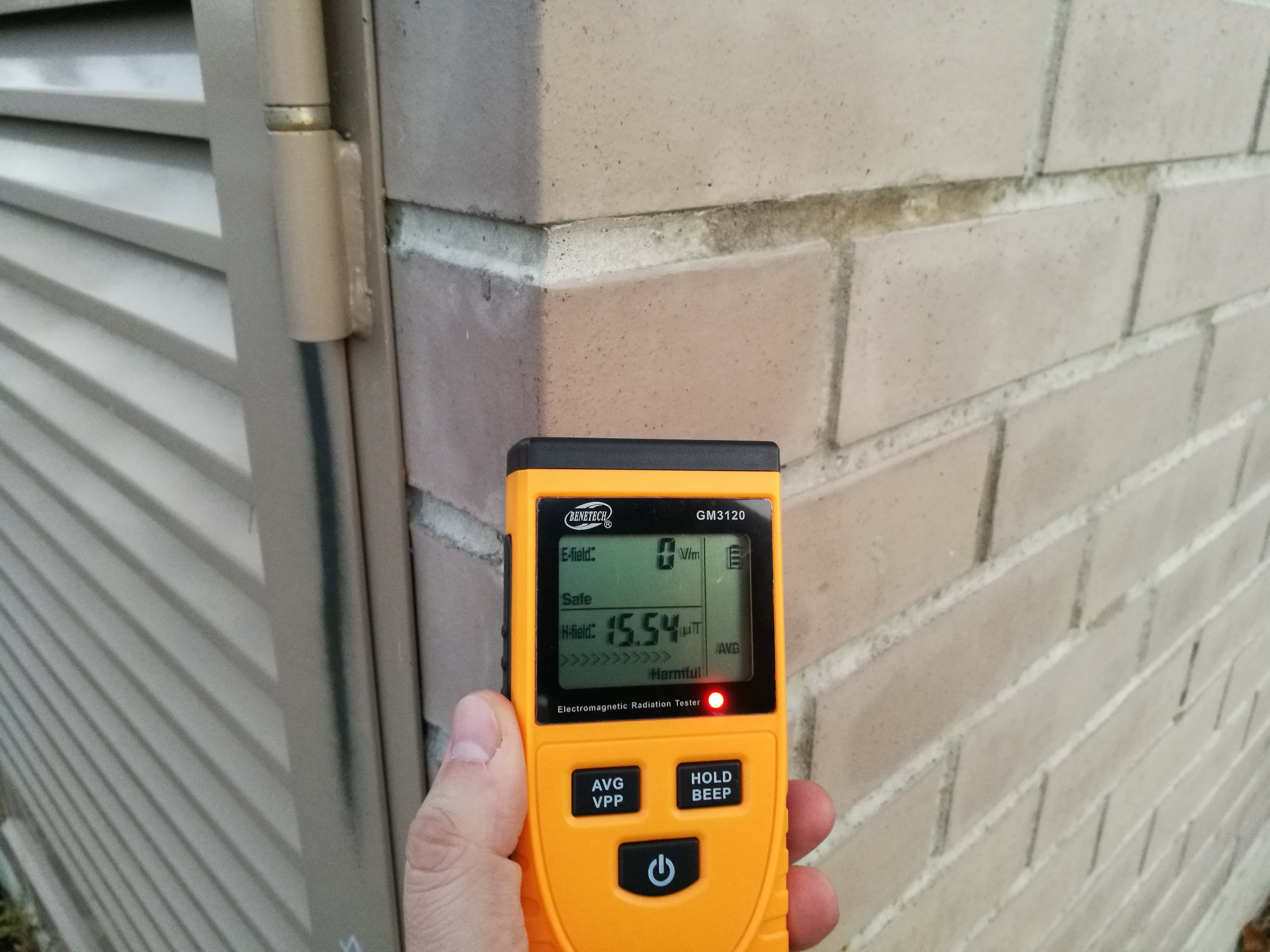
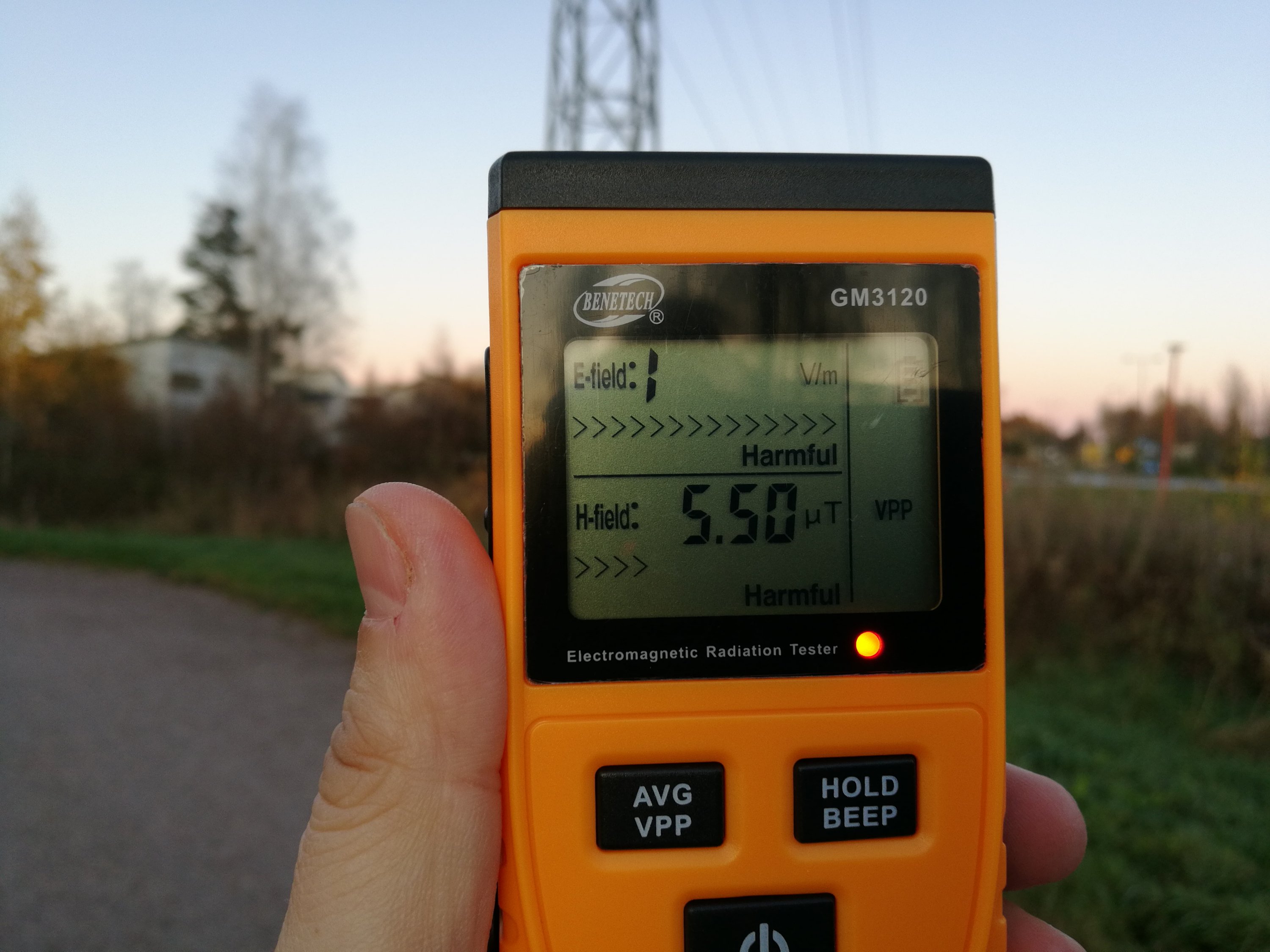
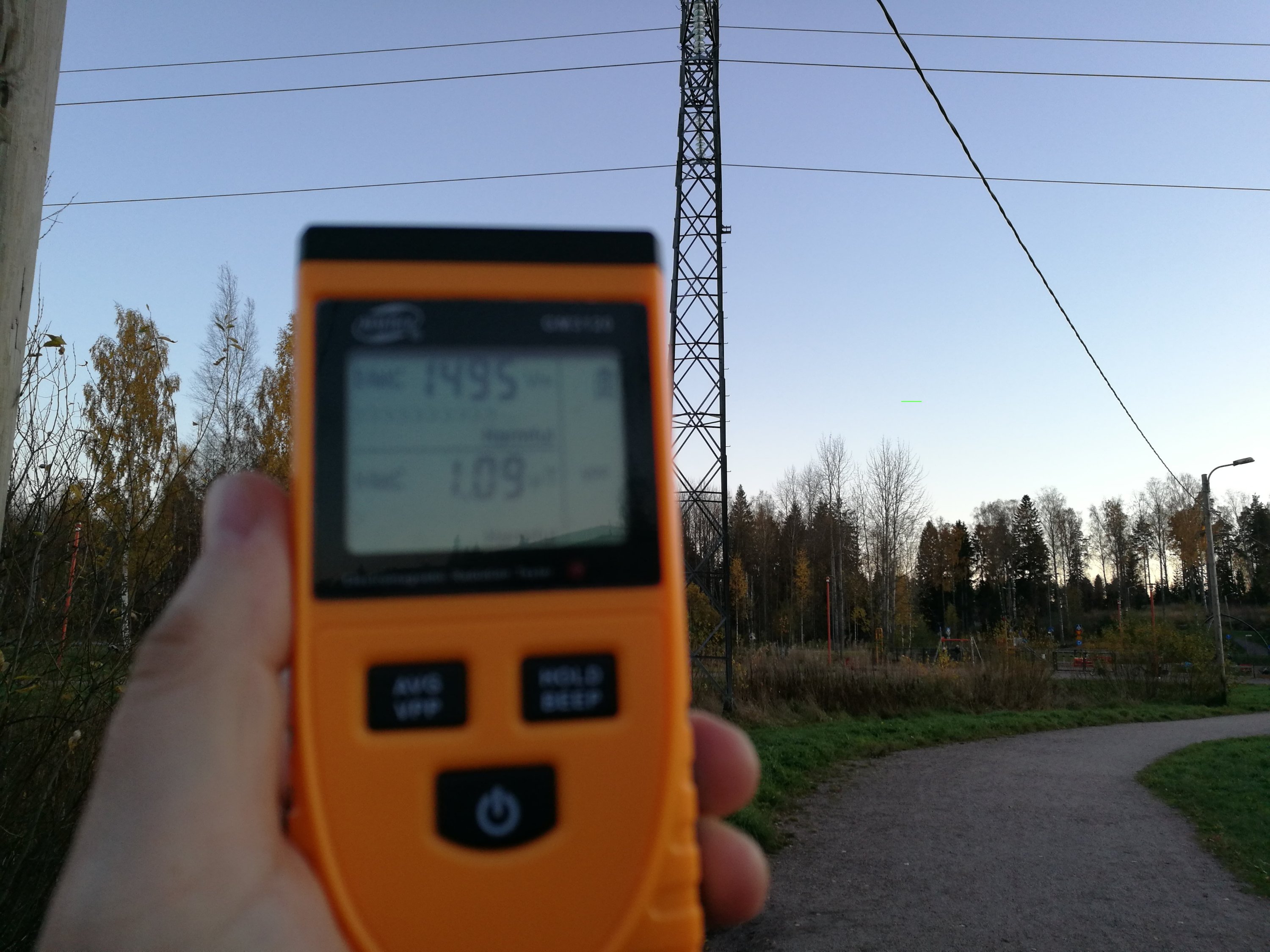
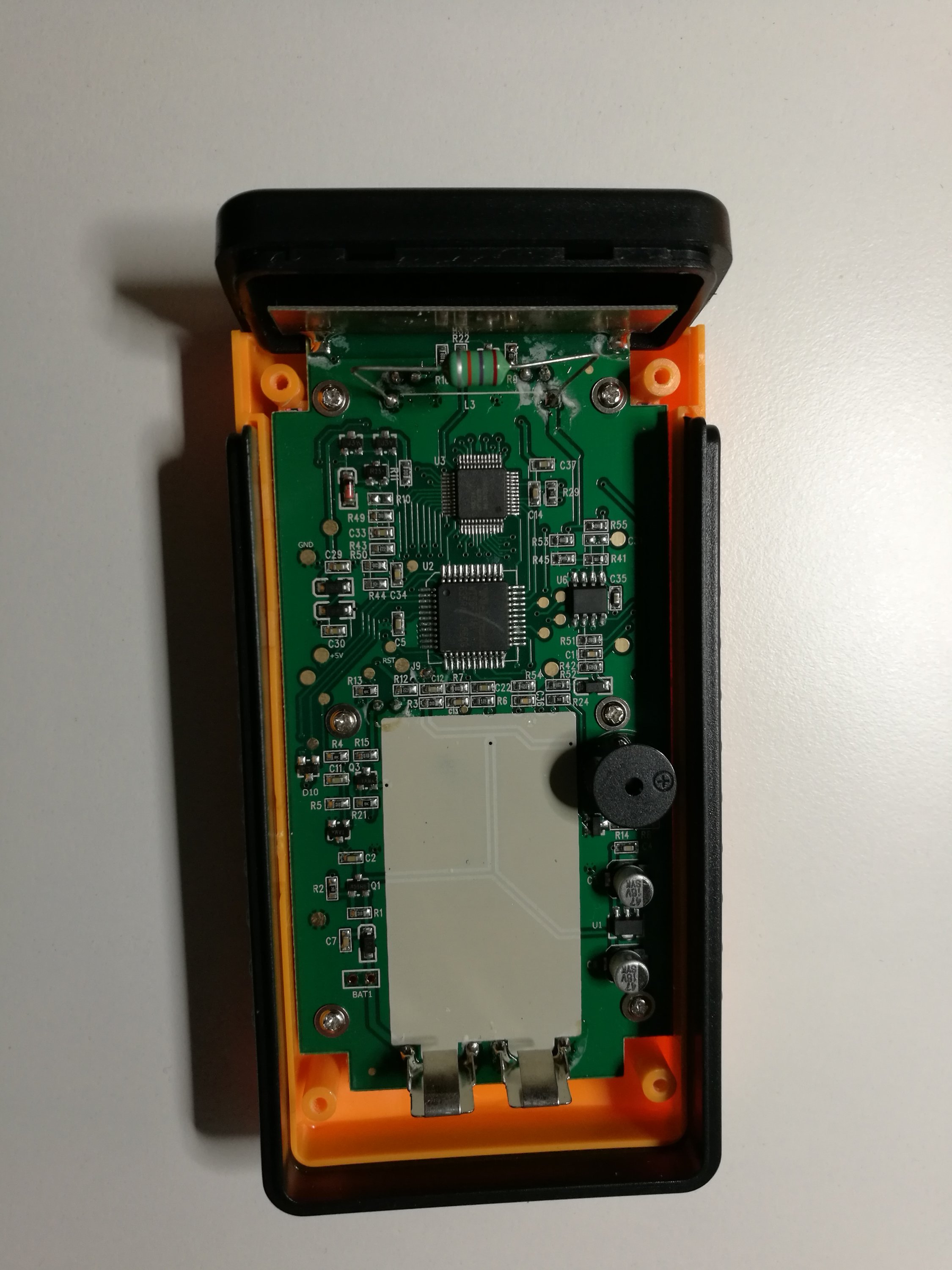
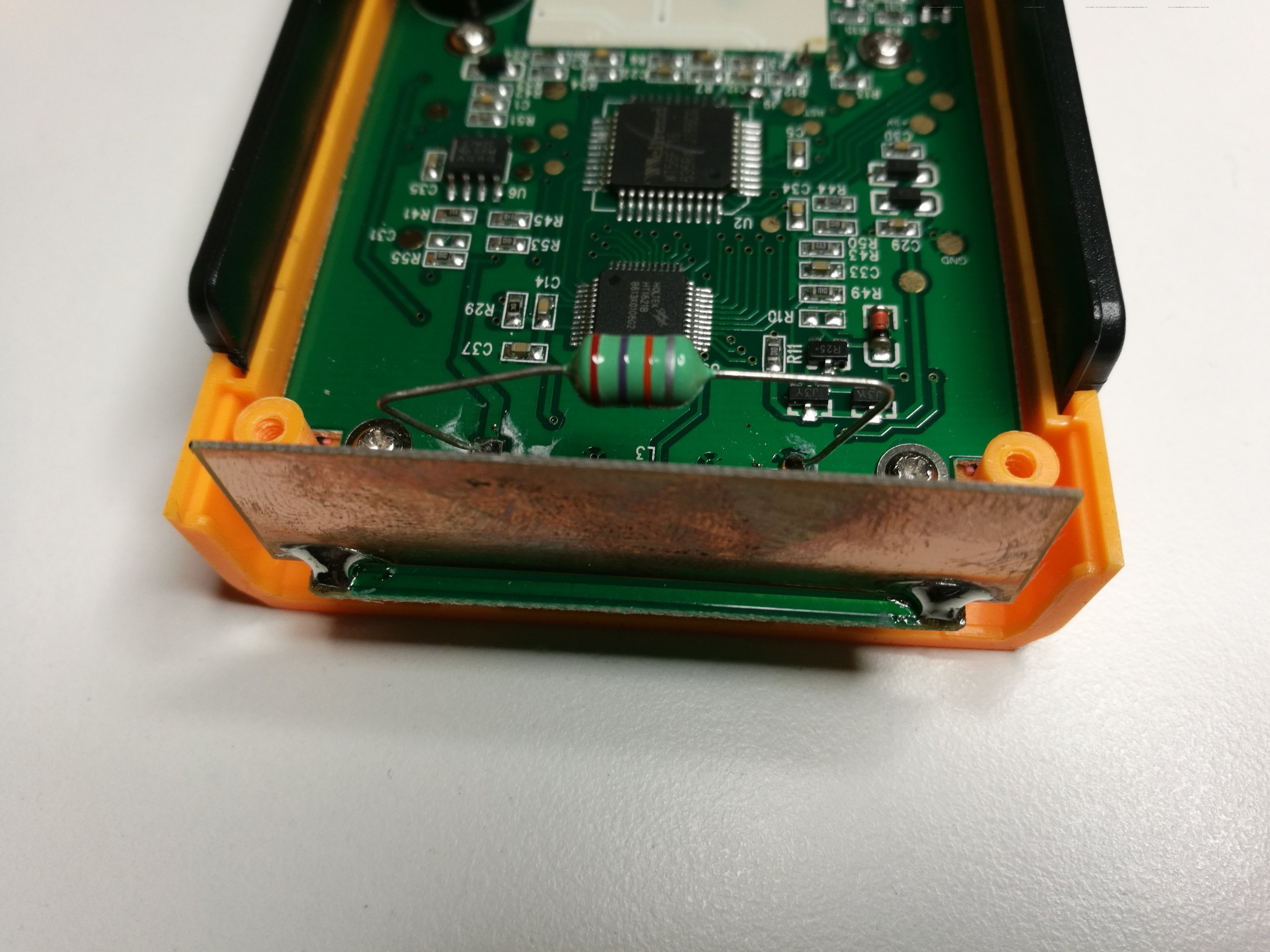
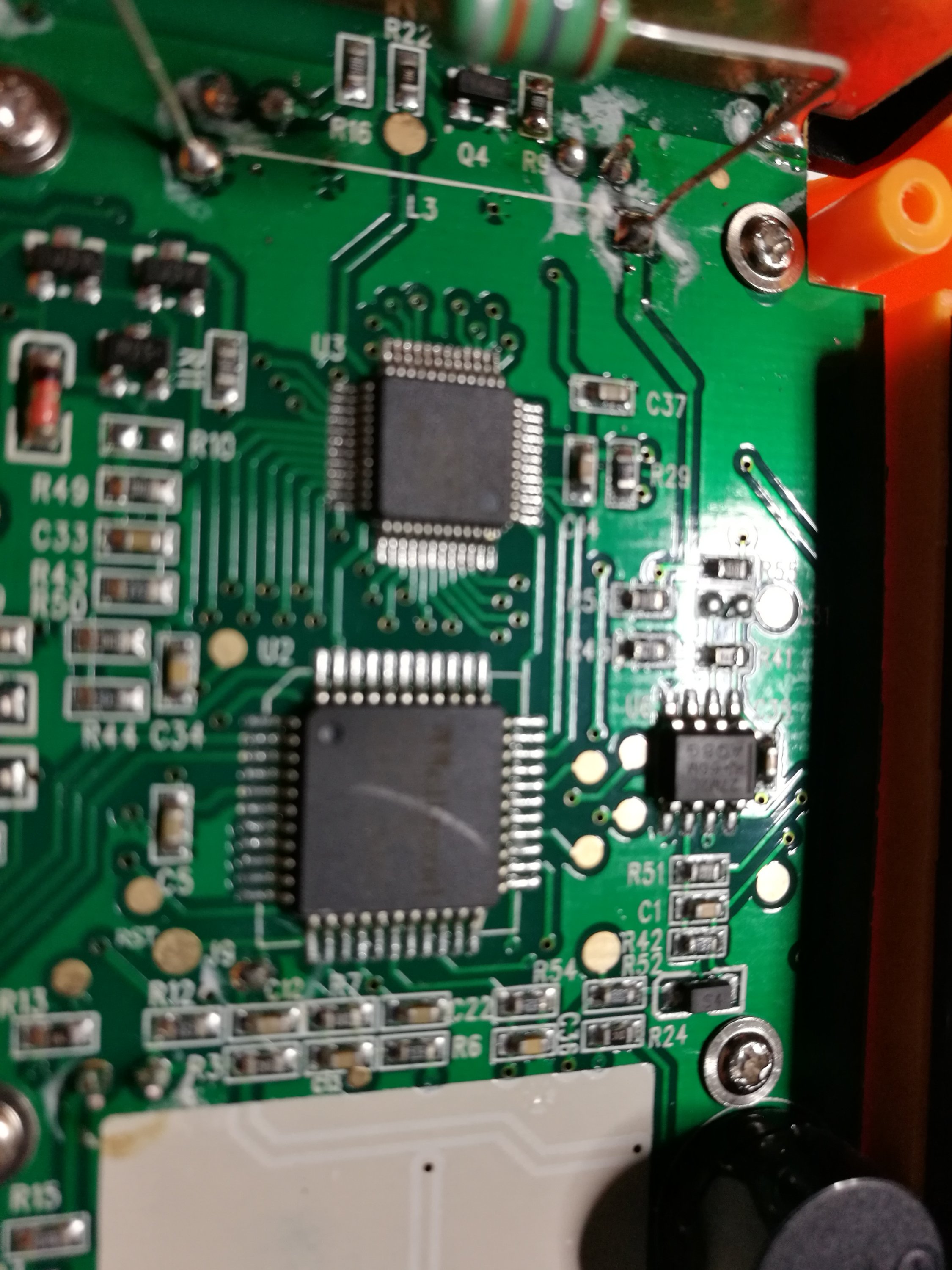
40 Comments
Tomi Engdahl says:
Fridge killed my baby? Mag-field radiation from household stuff ‘boosts miscarriage risk’
Living off grid, in the woods, away from all tech not such a loony idea after all
https://www.theregister.co.uk/2017/12/19/radiation_risk_miscarriage_study_says/
Analysis A study of 913 pregnant women in the San Francisco Bay Area, California, found those exposed to high levels of magnetic field (MF) non-ionizing radiation had a 2.72x higher risk of miscarriage than those exposed to low MF levels.
The Kaiser Permanente study, “Exposure to Magnetic Field Non-Ionizing Radiation and the Risk of Miscarriage: A Prospective Cohort Study,” was published this month in the journal Scientific Reports.
The authors, Kaiser researchers De-Kun Li, Hong Chen, Jeannette R. Ferber, Roxana Odouli, and Charles Quesenberry, say their findings add to the evidence that “MF non-ionizing radiation could have adverse biological impacts on human health.”
“In this study, we found an almost three-fold increased risk of miscarriage if a pregnant woman was exposed to higher MF levels compared to women with lower MF exposure,” the study says. “The association was independent of any specific MF exposure sources or locations, thus removing the concern that other factors connected to the sources of the exposure might account for the observed associations.”
Study participants were classified in four MF exposure groups – <2.5mG; 2.5–3.6mG; 3.7–6.2mG; and ≥6.3mG – based on 24 hours of measurements with an EMDEX Lite meter as a representation of daily exposure. The researchers did not find the miscarriage risk increased with doses above 2.5mG, leading them to theorize that 2.5mG represents a threshold level for health effects.
"The controversy over health effects from electromagnetic fields is, to a large extent, a product of earlier studies that did not find many associations between EMF and health risk,"
As Li observed, there is no scientific consensus that MF exposure harms human health. According to the National Cancer Institute, "[A]lthough many studies have examined the potential health effects of non-ionizing radiation from radar, microwave ovens, cell phones, and other sources, there is currently no consistent evidence that non-ionizing radiation increases cancer risk."
Cell Phones and Cancer Risk
https://www.cancer.gov/about-cancer/causes-prevention/risk/radiation/cell-phones-fact-sheet
Tomi Engdahl says:
Updated links to buy the device
https://www.banggood.com/GM3120-Electromagnetic-Radiation-Detector-Equipment-Meter-Home-Radiation-Monitoring-Phone-Dual-with-LCD-Displa-p-997966.html?p=2713145299682014043
Ravi Kachhadiya says:
Are You looking for Computer Shortcut Key? In this post i will tell you a lots of Computer Shortcut Key in our system. Also In the Computer Shortcut Key for keyboard is a set of multiple keys that invoke a particular command in our operating system.
Computer Shortcut Keys
Ravi Kachhadiya says:
https://www.9techupdate.com/computer-shortcut-key/
There are just amazing Computer shortcut keys
Tomi Engdahl says:
EMF measurements
http://www.epanorama.net/newepa/2013/02/12/emf-measurements/
Tomi Engdahl says:
EMF Meter – EMF Measurement – Basic Education: Using the Correct EMF Meter
https://www.youtube.com/watch?v=B_G8wM7RhGQ
Tomi Engdahl says:
EMF Dangers Cell Tower Radiation Dangers – Be Aware of Where You Live and Work!
https://www.youtube.com/watch?v=WaiXkXfbM98
Tomi Engdahl says:
Let’s Build A Field Strength Meter
https://www.youtube.com/watch?v=y-x2tVGPiE0
I follow Richard’s, KB3VZL, February 2015 QST (page 71) article about building a field strength meter into a DVM. He built the circuit to fit inside a Harbor Freight digital volt meter.
Tomi Engdahl says:
#007: Field Strength Meter Part 1
https://www.youtube.com/watch?v=ode80WeCDgI
Modification To Low Cost Harbor Freight DMM, Allows Measurement Of RF Field Strength. From Article In ARRL QST February, 2015.
#011: Field Strength Meter Part 2
https://www.youtube.com/watch?v=yJNBOx8TlLY
The Conclusion Of The Modification To The Low Cost Harbor Freight DMM, Allows Measurement Of RF Field Strength.
Tomi Engdahl says:
Teardown of a GM3120 Electromagnetic Radiation Tester
https://www.youtube.com/watch?v=5BXoqb9LRZE
In this video I did a teardown of a cheap eBay GM3120 field strength meter.
Teardown of a GM3120 Electromagnetic Radiation Tester
http://www.kerrywong.com/2018/05/20/teardown-of-a-gm3120-electromagnetic-radiation-tester/
Tomi Engdahl says:
Wide-band RF Field Strength Meter
http://www.kerrywong.com/2010/11/01/wide-band-rf-field-strength-meter/
Field strength meter is extremely useful when working with RF devices. It can be used to quickly diagnose whether a transmitter circuit is working, and can be used to detect RF signals in the environment.
The simplest field strength meter could be built with a tuned LC circuit and a germanium diode, just like the way of a building a crystal radio except replacing the ear piece with a high sensitivity current meter. While this approach fits the needs of most simple applications, it has a pretty narrow frequency range (~100 MHz) and requires tunning the LC circuit to the correct frequency before measurements can be made and the design can become complicated if wider frequency range tuning is desired.
Tomi Engdahl says:
Protection Radiation RF EMF/EMR – Meter ( GM3120 vs DT-1130 vs EM-0328 ) Νο1 – SY1ALF
https://www.youtube.com/watch?v=ru2u_aBYMfM
Protection Radiation RF EMF/EMR – Meter ( GM3120 vs DT-1130 vs EM-0328 ) – SY1ALF :
* * * * * * * * * *
Wi-Fi
Mobile Phone
Bluetooth
Wireless Phone DECT
Laptop
Tomi Engdahl says:
EMF Video
https://www.youtube.com/watch?v=fQHpI5xvDCo
How much is the electromagnetic force (EMF) increased if you live near a power line? Well, since the level is inversely related to the square of the distance from the source, if you’re 10 feet away from a source, the force is 1/100th of the force when you are 1 foot away. If you are 100 feet away, the force is 1/10,000th. The rapid drop-off of EMF is demonstrated by walking to and away from a power line and to and away from a typical transformer. while holding a gauss meter
Tomi Engdahl says:
Danger From Above: High Voltage Power Lines
https://www.belmarrahealth.com/danger-from-above-high-voltage-power-lines/
There’s been a lot of talk about electromagnetic fields (EMFs) and the bad effects of radiation from high voltage lines. The question is, is there any truth to it? Or is it just unnecessary fear-mongering by certain companies that sell you electronic gadgets that supposedly protect you from radiation?
Every time you use electricity and electrical appliances, you are exposed to artificial electric and magnetic fields at extremely low frequencies, below 300 hertz, that are considered extremely safe levels. More specifically, electric fields happen when you plug a wire into an outlet, even if the appliance is not turned on. Magnetic fields are formed when you actually are using a device, so electric current is flowing into the device.
One thing’s for certain: EMFs are strongest when you’re close to their source. As you go further from the source, the strength of the fields decreases rapidly. This means the strongest EMFs are right beside a transformer box or right under a high voltage power line, and they become weaker as you move away.
The thing is, any object, such as the walls of buildings, trees and even the ground where power lines are buried can block electric fields. So, when you are inside your home, the magnetic fields from high voltage power lines and transformer boxes are very weak. In fact, they are often weaker than the electromagnetic fields that come from your household electrical appliances.
That’s right. On a daily basis, most of us are exposed to EMFs caused by household wiring, lighting and any electrical appliance that plugs into the wall, including vacuum cleaners, electric barbecues and even toasters. In the workplace, EMFs can be created by computers, air purifiers, printers, electric tools and so on.
EMFs cause weak electric currents to flow through the human body, but the intensity of these currents is too low, many experts say, for concern.
there are people who are hypersensitive to electromagnetism, although the condition isn’t recognized by the medical community. These people experience headaches, fainting spells and extreme irritability when they are exposed even to the low frequency EMFs. Some of them have taken an extreme step to avoid them: They’ve moved to Green Banks, a small town in West Virginia where WiFi, TV, radio, cell phones and Bluetooth are banned.
As a doctor, I believe the stress from worrying about EMF could be greater than EMF itself. I would caution against moving right next to those high voltage transmission towers, but unless you’re planning on living completely off the grid, Fred Flintstone-style, or heading to Green Banks, you’re going to experience some exposure.
unplug all your gadgets when not in use, and use them a little less often!
Create distance between you and the EMF source, and minimize the time you spend exposed to the source.
Tomi Engdahl says:
EMF Ground current and stray voltage in apartment buildings
https://www.youtube.com/watch?v=xp2X23e6MMc
Russ Loader and his wife feel they have been harmed by the electromagnetic fields that are running underneath and along the floor in their Oshawa Ontario apartment. Even with the power turned off in their apartment, there is enough current running along the floor to light a christmas tree bulb. This can happen when electricity runs along grounded rebar or metal water pipes or other conduit that houses internet cables, security camera wires etc. Removing the grounded neutral wire from the pipes often corrects this problem.
Another source of EMF in the floor can come from transformers in florescent lighting fixtures that are installed in the ceiling of the apartment below.
Tomi Engdahl says:
Shielding Magnetic Fields from Wiring
https://www.youtube.com/watch?v=EeAcGell_cg
How to use MuMetal to shield the magnetic fields emitted from electrical wiring, and why in some cases shielding will not work
Tomi Engdahl says:
Comparing Shielding Performance of Space Blankets, Aluminum Mesh and Foil, Grounded and Ungrounded
https://www.youtube.com/watch?v=oXaFlqmphVk
We test the three leading materials for electromagnetic shielding using a 2.4 gigahertz Wi-Fi router. You will be surprised at which one is the worst.
Tomi Engdahl says:
Smart Meter Cover RF Radiation Shield Before and After Measurements
https://www.youtube.com/watch?v=xUxoC7Khl1o
Tomi Engdahl says:
EMF Protection: These actually work?!
https://www.youtube.com/watch?v=YQbXUouSZTU
Many people have asked me about the Q-Link and other similar gizmos.
You’re supposed to simply wear them, and they strengthen your body via “resonance” such that you are even protected from the negative effects of all kinds of EMF.
Well, I used to think that was nuts… Until my doctor friend said she loves hers!
So, I decided to take another look.
It turns out that the result of using these things is actually rather interesting…
Tomi Engdahl says:
Does it Work? Blocking EMF with Crystals: Shungite, Black Tourmaline, Selenite, Hematite…
https://www.youtube.com/watch?v=rdvrnl4b7ec
I tested the EMR radiation (EMF, EF, RF) ability of these crystals/rocks: Shungite, Black Tourmaline, Selenite, Hematite, Pink Himalayan Salt Rock, and also Aluminum Foil.
I was skeptical about the blocking ability of the crystals/rocks and their practical use if they were able to block radiation.
Since I understood how you could use metals to build a Faraday cage that would be able to block EM radiation, I thought using aluminum foil would be more effective.
Article: Understand And Block Cellphone, Wireless, Microwave, EMR, EMF, EF, RF Radiation:
Understand And Block Cellphone, Wireless, Microwave, EMR, EMF, EF, RF Radiation
https://www.naturallifeenergy.com/understand-and-block-cellphone-wireless-microwave-emr-emf-ef-rf-radiation/
Tomi Engdahl says:
Cell Phone EMF-Blocking Products – A Real World Test
https://www.youtube.com/watch?v=_M4DFGEjiaI
From cell phone cases to blankets, ConsumerWatch Reporter Julie Watts put some of the most popular EMF-blocking products to the test. (11/14/17)
Tomi Engdahl says:
EMF Protection Clothing RF Microwave Shielding Hat and Hood
https://www.youtube.com/watch?v=B6U1FifYlUg
This is an intelligent challenge, so I thank all of you! I have met your challenges. I figured out a better way to test these products using a top of the line RF meter with a ‘unidirectional’ antenna, to show you how effective the EMF protecting products actually are.
The reduction in the microwave radiation exposure shown in this video proves the claims and specifications as provided by the manufacturer at a 99.9% effective shielding capacity!
Shielding a Bedroom From EMF Emitted by Cell Towers Using YShield Paint
https://www.youtube.com/watch?v=JidHf1PWAVs
In this video, we will show how we effectively block harmful EMF high-frequency/RF radiation generated by cell towers from entering a room in a house. We use specially designed paint from YShield, which prevents this radiation from passing through walls.
Tomi Engdahl says:
Researchers found bees generate electric fields that tell other pollinators when they’ve visited a flower
Bees use shark ‘supersense’ to help find food
https://horizon-magazine.eu/article/bees-use-shark-supersense-help-find-food.html
Flying insects such as bees and moths have secret senses that allow them to ‘feel’ nearby flowers and navigate over long distances, according to new research.
Armed with sensitive antennae and wide-angled compound eyes, bees have a sophisticated set of senses to help them search out pollen and nectar as they buzz from flower to flower.
Tomi Engdahl says:
BECOME VERY UNPOPULAR VERY FAST WITH THIS DIY EMP GENERATOR
https://hackaday.com/2016/10/12/become-very-unpopular-very-fast-with-this-diy-emp-generator/
Tomi Engdahl says:
https://www.facebook.com/jurij0001/videos/electromagnetic-field-sensor/381681453057544/
Ric says:
I am using one of these to measure magnetic fields from Power Lines because we are interested in buying a house approx 200 metres from some. I found the mf dissipated to zero/negligible at approx 80 metres away. Have you done any similar surveys? I’d be interested to hear your results.
Tomi Engdahl says:
The electrical and magnetic fields dissipate on many power lines very quickly. Few tens of meters and they are very much attenuated.
I live less than 100 meters from a power line, and the electrical and magnetic fields I can measure near my house is very small.
I did some measurements before moving here, because the nearby 110 kV line seemed to be very close. But the levels were nothing to worry about.
How much the fields change varies on the power line type (voltage and current) and how the power lines are located among each other.
On the power line shown in
https://www.epanorama.net/blog/2020/11/24/under-the-110-kv-power-line/
at picture https://www.epanorama.net/blog/wp-content/uploads/2020/11/20201114_144318.jpg
the fields below the line are very high, but they attenuate very quickly when you move away from the power line.
You see that the nearest houses are not very far.
The electrical field on this configuration is very high below line, and magnetic field quite high.
If you move on the ground level away from line, those drop very quickly.
I have understood that in this configuration magnetic field on the side of the line would be considerably higher up on the level where the wires are, but that’s not an issue because nobody would be near the lines at this height as the buildings are not that tall.
Typical magnetic field levels near power lines
https://www.bchydro.com/safety-outages/power-lines-and-your-health/electric-and-magnetic-fields-from-power-lines.html
Tomi Engdahl says:
Power Line Meter which measures high frequency electric fields present on your power lines in milliVolts Peak-to-Peak. It captures frequencies between 10 KHz and 10 MHz. These high frequency electric fields are commonly known as Dirty Electricity.
https://safelivingtechnologies.com/products/line-emi-meter.html
Tomi Engdahl says:
Review: What On Earth Is An Electromagnetic Radiation Tester And Why Would I Need One?
https://hackaday.com/2021/04/07/review-what-on-earth-is-an-electromagnetic-radiation-tester-and-why-would-i-need-one/
today’s subject, a Mustool MT525 electromagnetic radiation tester. At a cost not far above £10 ($13.70), this was an impulse purchase driven by curiosity; these devices claim to measure both magnetic and electric fields, but what do they really measure? My interest in these matters lies in the direction of radio, but I have never examined such an instrument. Time to subject it to the Hackaday treatment.
Who Knew Everything Was So Harmful!
Out of the box comes a smart handheld unit with three buttons and an LCD display, and an instruction leaflet. On the rear of the case is a battery compartment, this takes three AAA cells. It claims to measure electric fields from 1 V/m to 1999 V/m, and magnetic fields from 0.01 μT to 99.99 μT, with a bandwidth from 5 Hz to 3500 MHz. Opening the instruction leaflet it becomes clear that this is intended for use in monitoring electromagnetic fields for the purpose of human safety, with a list of conditions from leukemia to blindness that they can cause.
Powering it up gives a zero reading for both measurements when held in free space in this very average house, increasing markedly when held near various electronic appliances. Particularly concerning is a beeper that sounds when either level is considered harmful, which it does in proximity to a horrifying number of items including the laptop keyboard and trackpad this is being written with
The alarm threshold values for that beeper are 40 V/m and 0.4 μT respectively, and given that it sounds the alarm on such mundane things as my keyboard I have to question what that means. Reading around the subject of typical safe exposure levels it becomes obvious that the alarm is set far too low, and I have to wonder whether it might cause unnecessary worry in a person who had bought this unit because of a personal concern for electromagnetic field levels. Fortunately the beep can be disabled with a long press of a button.
So having described what it does, what’s inside the case? On the back are four small screws, and with those undone it splits into two to reveal a circuit board. At the business end of the unit are the sensors, a metal plate for electric fields and a wire-ended inductor for magnetic ones, and their outputs are each fed to their own TI TLC27M2 dual op-amp. These in turn feed a Weltrend WT56F216 microcontroller which boasts an 8052 core and analogue inputs, that drives the LCD via a Holtek HT1621 LCD controller.
It appears to be a well-engineered instrument that does what it claims, and measures the presence and strength of oscillating electric and magnetic fields. But is it an instrument that’s any use, should I trust it, and does it have a space on my bench? I am curious about its calibration for a start, it’s hardly as though I’d expect any traceable calibration certificate from such a cheap item, but are the V/m and μT figures even in the right ballpark? I am also concerned about the way it and devices like it are sold for health purposes, it worries me that there might be people driven to unnecessary worry by its “Harmful” beeper when in reality they have no need. For myself, I can report that it’s a handy way to check for a field at close quarters, and it works at common amateur radio frequencies, though I can’t really claim it has much use as a bench instrument.
Tomi Engdahl says:
Radiation: Electromagnetic fields
https://www.who.int/news-room/q-a-detail/radiation-electromagnetic-fields
Key points
Background electromagnetic field levels in the home are mainly caused by the transmission and distribution facilities for electricity or by electrical appliances.
Electrical appliances differ greatly in the strength of fields they generate. Both electric and magnetic field levels decrease rapidly with distance from the appliances. In any event, fields surrounding household appliances usually are far below guideline limits.
At operator positions the electric and magnetic fields of television sets and computer screens are hundreds of thousands times below guideline levels.
Microwave ovens meeting the standards are not hazardous to health.
As long as close public access to radar facilities, broadcasting antennas and mobile phone base stations is restricted, exposure guideline limits for radiofrequency fields will not be exceeded.
The user of a mobile phone encounters field levels that are much higher than any levels in the normal living environment. However, even these increased levels do not appear to generate harmful effects.
Many surveys have demonstrated that exposure to electromagnetic field levels in the living environment is extremely low.
Tomi Engdahl says:
listed at https://www.who.int/news-room/q-a-detail/radiation-electromagnetic-fields
For 50 Hz fields Public exposure limits (Occupational exposure limits)
Electric field (V/m) 5000 (10000)
Magnetic field (µT) 100 (500)
Tomi Engdahl says:
The strength of the magnetic field is expressed in units of Tesla (T) or microtesla (µT). Another unit, which is commonly used is the Gauss (G) or milligauss (mG), where 1 G is equivalent to 10-4 T (or 1 mG = 0.1µT). There are a range of different instruments that can measure magnetic field strength.
Measuring magnetic fields
Magnetic fields within homes can vary at different locations and also over time.
https://www.arpansa.gov.au/understanding-radiation/radiation-sources/more-radiation-sources/measuring-magnetic-fields
Electric and magnetic fields from electricity
Everything electrical, from a toaster to a high-voltage powerline, produces electric and magnetic fields. In Australia, the electric and magnetic fields associated with the use of electricity are generated at a frequency of 50 hertz (Hz) (50 cycles per second).
Both the electric and magnetic fields are strongest close to an operating electrical source. The strength of the electric field depends on the voltage (typically 240 Volts for households) and is present in any live wire whether an electrical appliance is being used or not. Magnetic fields, on the other hand, are produced by electric currents and are only present when an appliance is operating i.e. there is no magnetic field when an electrical appliance is turned off.
Do electrical sources cause any health effects?
There is no established scientific evidence that exposure to the electric and magnetic fields found around the home, the office or near powerlines causes adverse health effects. However, there are some epidemiological (population) studies that have reported a possible association between prolonged exposure to extremely low frequency (ELF) magnetic fields at levels higher than typical and increased rates of childhood leukaemia. Other research including studies on cells and animals has not confirmed these results. On balance, the evidence related to childhood leukaemia is not strong; however people should be aware of the issue in order to make informed decisions.
Tomi Engdahl says:
How Do You Measure the Magnetic Field?
https://www.wired.com/2014/01/measure-magnetic-field/
There’s a magnetic field and you need to measure its strength. But how? Here are some options. Magnetic Compass Back when I was a kid, we had these things called compasses. It’s just a magnetic needle inside a case that is free to rotate. Since a magnetic field can exert a torque on another magnet, […]
Tomi Engdahl says:
https://en.wikipedia.org/wiki/Magnetic_field
OVERVIEW OF MAGNET MEASUREMENT METHODS
https://cds.cern.ch/record/382438/files/p127.pdf
Tomi Engdahl says:
Science Projects
Measuring Magnetic Fields
https://www.sciencebuddies.org/science-fair-projects/project-ideas/Elec_p030/electricity-electronics/measure-magnetic-fields
Build a circuit that can measure magnetic field strength and measure how field strength changes with distance.
Measuring the strength of a magnetic field
https://spark.iop.org/measuring-strength-magnetic-field#gref
Tomi Engdahl says:
Current Balance Experiment (measure magnetic field strength)
https://www.youtube.com/watch?v=N4H1X4i2OZ4
Experiment to determine the magnetic flux density for a permanent magnet. This video is carrying out the experiment, video 2 (youtu.be/hIJoLiRGjjo) has the analysis of results.
Search Coil Experiment (measure magnetic field strength)
https://www.youtube.com/watch?v=vb8KwB0ANrg&t=0s
Tomi Engdahl says:
Magnetic Fields, Flux Density & Motor Effect – GCSE & A-level Physics
https://www.youtube.com/watch?v=o0yfYTtR6go
00:00 Magnetic field lines
04:51 Magnetic flux & flux density (field strength)
07:00 Field around current in wire
08:17 Motor effect, F=BIL, Fleming’s left hand rule
15:04 Experiment
Tomi Engdahl says:
What’s the right tool for magnetic measurements?
https://qd-europe.com/fi/en/news/product-application-news-spectrum/whats-the-right-tool-for-magnetic-measurements/
Magnetic fields can be measured in many ways. The determining factor is the physical property that is to be measured. It is possible to measure the magnetic field strength at a certain position or the magnetic flux through a defined surface.
Teslameter
The magnetic field strength is measured in Tesla or Gauss, hence the name of the corresponding measurement system: Teslameter.
A measurement head is needed for the measurement. Two different geometries are available: sensors and probes (measurement heads with handle).
Both can:
measure field strengths at a given point in space
measure the magnetic field in small areas or gaps
perform rapid, individual static measurements
measure AC and DC fields
create high-resolution magnetic field maps
The basis for all measurements is the Hall effect. The Hall effect is the production of a potential difference in a current-carrying conductor in the presence of a magnetic field. The potential difference is perpendicular to the magnetic field and, for a set current I, proportional to the magnetic field.
Due to this strong directional dependence, it is of utmost importance to choose the right sensor or probe. There are three different types:
Transversal sensors and probes are ideal for measurements of fields between narrow slits, where north and south pole are opposite each other and create a homogeneous field, and on surfaces which are passed by magnets
Axial sensors and probes for measurements inside cylindrical coils or magnetizers
3-axis sensors and probes. They combine the properties of the other two types while being larger. The teslameter can calculate the entire field and the individual x-, y- and z-components
Fluxmeter
With a combination of fluxmeter and Helmholtz coil, additional parameters like magnetic flux, flux density, magnetic field strength, dipole movements and magnetic potential can be measured.
Fluxmeters measure magnetically induced voltage in coils. Compared to teslameters, fluxmeters are more complicated to operate due to the large number of measurable variables.
Typical applications are:
definition of the total magnetization of a magnet
measurement of the magnetic flux within fixed objects like coil cores
dipole measurements of permanent magnets with help of a Helmholtz coil
construction of proprietary coils and their characterization
measurement of high-frequency fields
A fluxmeter uses a conductor loop or coil to identify the perpendicular magnetic flux. The measurement thus depends on the size of the coil. To measure magnetic flux, flux must be generated by movement of the individual components.
Tomi Engdahl says:
DIY ULTRA-SENSITIVE EMF (Electromagnetic field) Detector © GPL3+
https://create.arduino.cc/projecthub/mircemk/diy-ultra-sensitive-emf-electromagnetic-field-detector-529d89
This device can also be called an EMF meter, as it can measure the relative strength of a field using a scale of 10 LEDs.
Tomi Engdahl says:
Parkside Electromagnetic Field Detector PEM A1 REVIEW
https://www.youtube.com/watch?v=8VvTFiacEhI